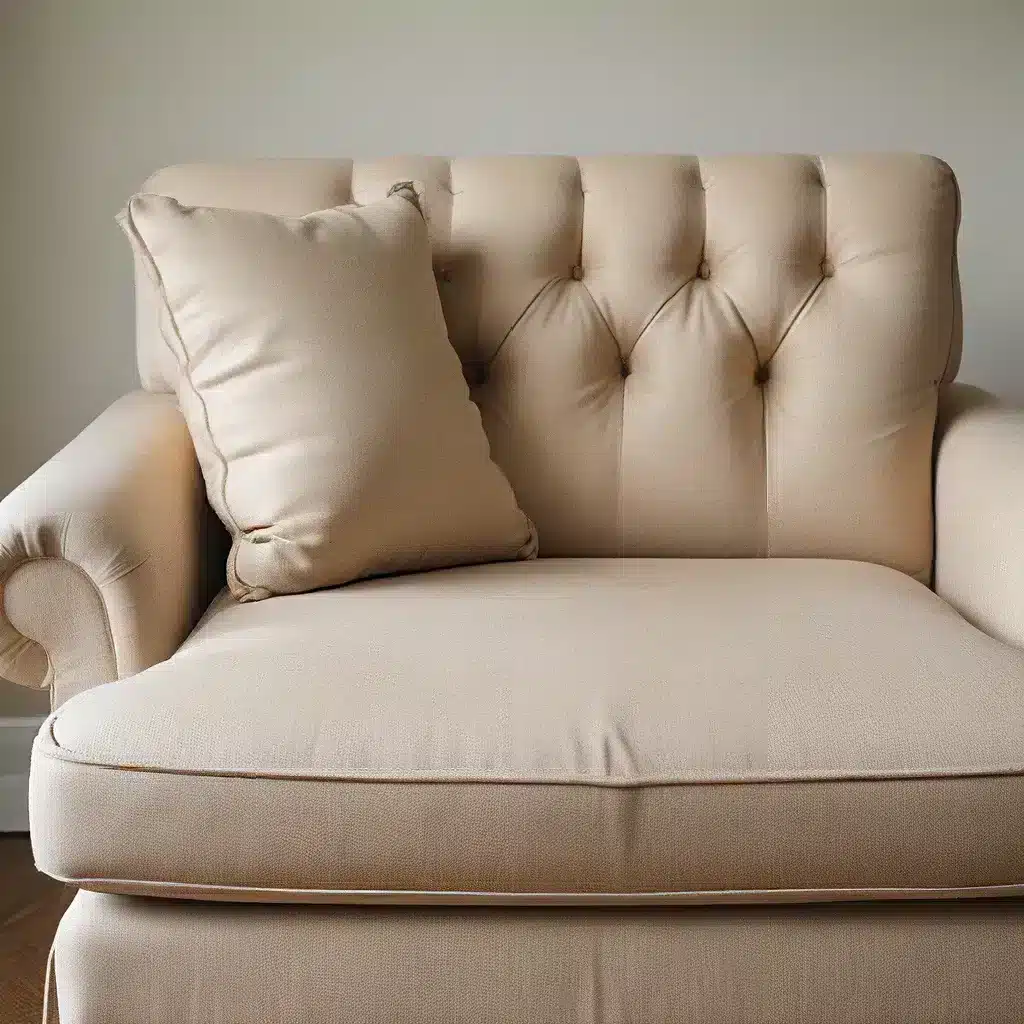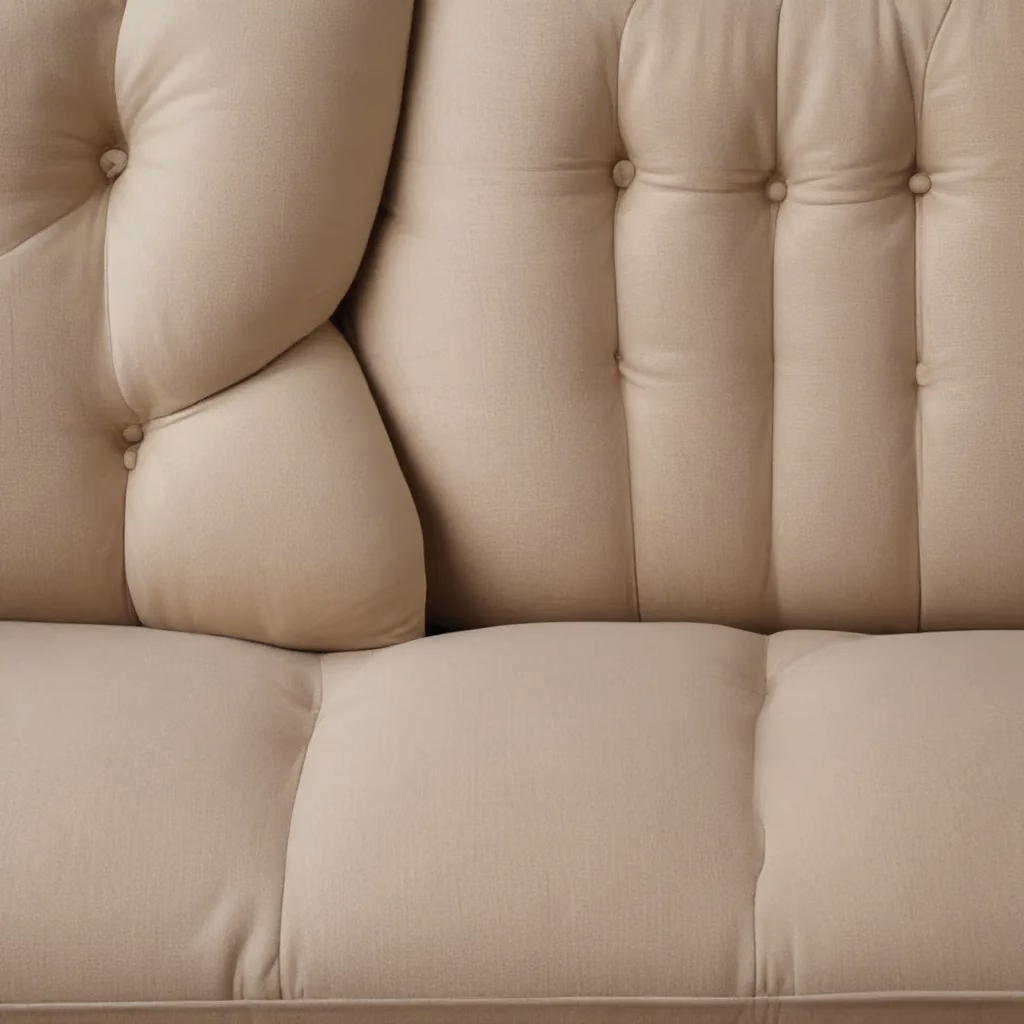
Solving the Sun’s Stubborn Stain: A Guide to Reviving Your Beloved Sofa
As I sit here admiring the stunning custom sofa from Sofaspectacular, I can’t help but reminisce about the journey that led me to this point. You see, not too long ago, I stumbled upon a true gem at a local thrift store – a beautiful Thomasville sofa that had fallen victim to the relentless glare of the sun. The upholstery was faded, tired, and in dire need of some TLC.
But being the eternal optimist that I am, I couldn’t resist the challenge. I was determined to breathe new life into this sofa and restore it to its former glory. And let me tell you, it wasn’t an easy task, but the sense of accomplishment I felt when I was done? Priceless.
So, if you’re in a similar situation, fear not! I’m here to share my hard-earned wisdom and guide you through the process of fixing discolored or faded upholstery. Whether you’ve got a sun-kissed sofa, a tired-looking armchair, or a lackluster loveseat, this article will be your roadmap to a fresh, vibrant, and rejuvenated piece of furniture.
Understanding the Causes of Faded Upholstery
Before we dive into the nitty-gritty of restoration, it’s important to understand what’s causing the discoloration in the first place. The culprit, more often than not, is none other than that bright, shining star in the sky – the sun.
You see, the ultraviolet (UV) rays emitted by the sun are incredibly powerful, and they can wreak havoc on our beloved fabrics. Over time, these rays break down the molecular structure of the fibers, causing them to lose their color and vibrancy. It’s like a slow-motion battle between your sofa and the sun, and unfortunately, the sun usually comes out on top.
But the sun isn’t the only villain in this story. Other factors, such as exposure to harsh cleaning chemicals, general wear and tear, and even the natural aging process can all contribute to the fading of upholstery. It’s a complex issue, but understanding the root causes is the first step in finding a solution.
Assessing the Damage: A Closer Look at Your Faded Upholstery
Now that we know what’s behind the discoloration, it’s time to take a closer look at the damage and determine the best course of action. Grab a magnifying glass, put on your detective hat, and let’s investigate.
First and foremost, it’s crucial to identify the type of fabric you’re working with. Is it a natural fiber like cotton or linen, or a synthetic blend like polyester or microfiber? The composition of the fabric will play a big role in the restoration process, so it’s essential to know what you’re dealing with.
Next, examine the extent of the fading. Is it localized to certain areas, or is the discoloration more widespread? This will help you decide whether a targeted approach or a full-scale revamp is in order.
And don’t forget to check for any additional damage, such as tears, stains, or worn spots. These issues will need to be addressed as well, so it’s best to get a comprehensive understanding of the sofa’s condition before you start.
By taking the time to thoroughly assess the situation, you’ll be able to develop a tailored plan of attack, ensuring that your restoration efforts are as effective and efficient as possible.
Exploring Your Options: Fixing Faded Upholstery
Now that we’ve got the groundwork laid, it’s time to explore the various techniques and methods you can use to fix your discolored or faded upholstery. Get ready, because we’re about to dive into a world of fabric dyes, reupholstering, and more.
Fabric Dyes: Breathe New Life Into Your Sofa
One of the most popular and accessible options for reviving faded upholstery is the use of fabric dyes. These magical potions can help restore the original color of your sofa, or even transform it into a completely new, vibrant hue.
Now, I know what you’re thinking: “Dye in my washing machine? Isn’t that a recipe for disaster?” And you’d be right to be cautious. Improperly using fabric dyes can definitely lead to a catastrophic mess, but with the right techniques and a little bit of patience, you can achieve stunning results.
The key is to follow the instructions on the dye package to a T, and to make sure you’re using a product that’s specifically designed for upholstery fabrics. Brands like Rit and Dylon offer excellent options that are easy to use and deliver long-lasting color. Just be sure to test the dye on a small, inconspicuous area of the sofa first to ensure a perfect color match.
And don’t be afraid to get a little creative! If you’re feeling adventurous, you can even experiment with color-mixing or ombre effects to really make your sofa stand out.
Reupholstering: A Blank Canvas for Your Design Visions
If the fading is too extensive or the fabric is in poor condition, reupholstering might be the way to go. This is a more involved process, but it also gives you the opportunity to completely transform the look and feel of your sofa.
The great thing about reupholstering is that you’re not limited to just fixing the fading. You can choose a completely new fabric that better suits your style and décor, or even incorporate exciting design elements like patterns, textures, or bold colors.
And the best part? You don’t have to do it all yourself. There are plenty of talented upholsterers out there who can take your vision and turn it into a reality. Just be sure to do your research, read reviews, and get quotes from a few different providers to find the one that’s the perfect fit for your project and your budget.
Painting: A Unique Twist on Fabric Restoration
If you’re feeling particularly adventurous, you might want to consider painting your faded upholstery. Now, I know what you’re thinking: “Painting fabric? Isn’t that going to make it stiff and uncomfortable?” And you’d be right to be skeptical.
However, there are specialized fabric paints and coatings on the market that can help you achieve a fresh, vibrant look without compromising the soft, supple feel of your sofa. Products like Duplicolor’s High Gloss Vinyl and Fabric Coating can be sprayed directly onto the fabric, providing a durable, long-lasting finish that won’t crack or peel over time.
The key is to take your time, follow the instructions carefully, and test the paint on a small, inconspicuous area first. And don’t be afraid to get a little creative with techniques like ombre, stenciling, or even hand-painting intricate designs. The possibilities are endless!
Slipcovers: A Quick and Convenient Solution
If you’re not quite ready to commit to a full-scale restoration project, slipcovers might be the way to go. These removable fabric covers can be an excellent way to breathe new life into your faded sofa without having to do any major work.
The great thing about slipcovers is that they come in a wide variety of styles, fabrics, and colors, so you can easily find one that perfectly complements your existing décor. And if you ever get tired of the look, you can simply swap it out for a new one.
Plus, if you’re the type of person who likes to change things up regularly, slipcovers can be a godsend. You can have a different look for every season, holiday, or mood, all without having to worry about the underlying upholstery.
Putting It All Together: A Step-by-Step Guide to Sofa Restoration
Okay, now that we’ve explored all the different options, it’s time to put together a step-by-step plan for restoring your faded upholstery. Get ready, because this is where the real magic happens.
Step 1: Assess and Prepare
As we discussed earlier, the first step is to thoroughly examine the condition of your sofa and identify the type of fabric you’re working with. Once you’ve got a clear understanding of the situation, it’s time to prepare the surface for treatment.
This might involve cleaning the fabric to remove any dirt, dust, or stains, or even lightly sanding the surface to help the dye, paint, or slipcover adhere more effectively. Just be sure to follow the manufacturer’s instructions and test any cleaning or prepping products in an inconspicuous area first.
Step 2: Choose Your Restoration Method
Now that you’ve got a solid understanding of the fabric and the extent of the damage, it’s time to decide on the best restoration method. Will it be fabric dyes, reupholstering, painting, or slipcovers?
Take your time with this step, and don’t be afraid to mix and match techniques if necessary. For example, you might use a fabric dye to address the fading, and then top it off with a slipcover for an extra layer of protection and style.
Step 3: Execute Your Plan
Once you’ve got your plan in place, it’s time to put in the hard work. Whether you’re carefully applying dye, meticulously reupholstering, or expertly installing a slipcover, each step of the process requires attention to detail and a steady hand.
Don’t be afraid to take your time and double-check your work. Remember, the end result is going to be a showstopping piece of furniture that you can enjoy for years to come, so it’s worth getting it right.
Step 4: Admire Your Handiwork
And finally, the moment you’ve been waiting for – the big reveal! Take a step back and bask in the glory of your newly restored sofa. Soak in that sense of accomplishment and pride, because you’ve just transformed a tired, faded piece of furniture into a stunning, vibrant masterpiece.
Now, all that’s left to do is to kick back, relax, and enjoy your hard-earned victory. Congratulations, my friend, you’ve officially joined the ranks of the furniture restoration elite!
Conclusion: Embracing the Beauty of a Renewed Sofa
As I sit here, gazing adoringly at my beautifully restored Thomasville sofa, I can’t help but feel a deep sense of satisfaction. What once was a faded, forgotten relic has been transformed into a true showpiece, a testament to the power of determination and a little bit of elbow grease.
And you know what? I wouldn’t have it any other way. The journey of restoring this sofa has been filled with challenges, surprises, and a whole lot of laughter, but in the end, it’s all been worth it. Because now, every time I sink into the plush cushions, I’m reminded of the hard work and creativity that went into bringing this piece back to life.
So, if you’re staring at a sun-drenched sofa, or a tired-looking armchair that’s seen better days, don’t lose hope. Embrace the opportunity to breathe new life into your beloved furniture, and let your imagination run wild. Who knows, you might just end up with a one-of-a-kind masterpiece that you’ll cherish for years to come.
Happy restoring, my friends! And remember, the team at Sofaspectacular is always here to help if you need a little extra inspiration or guidance along the way.



